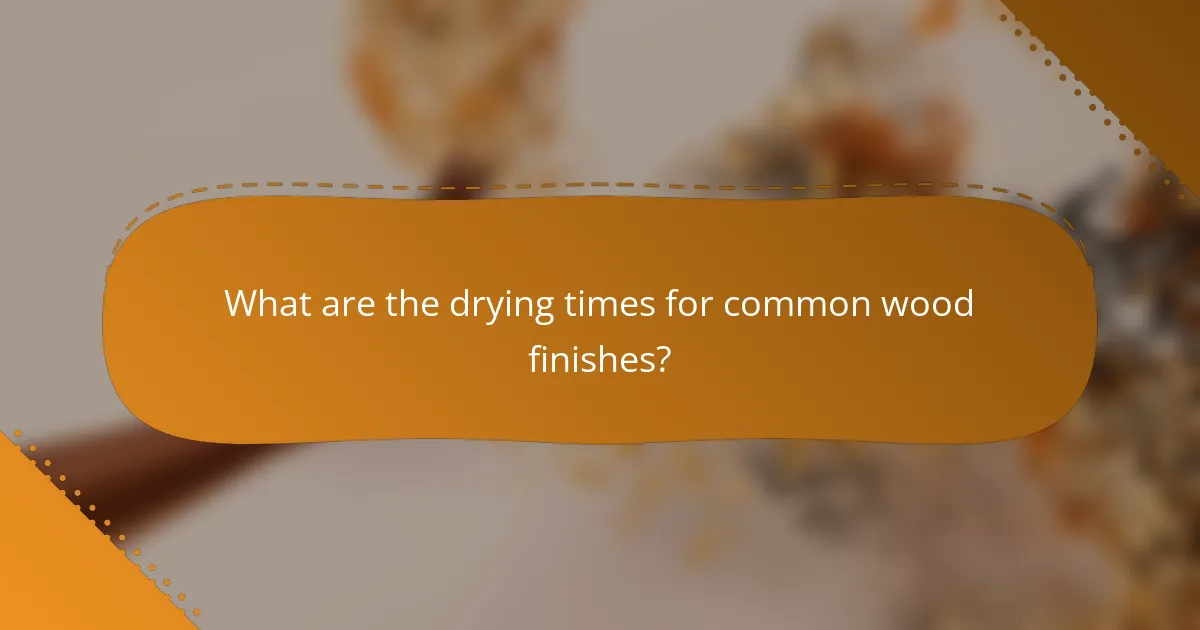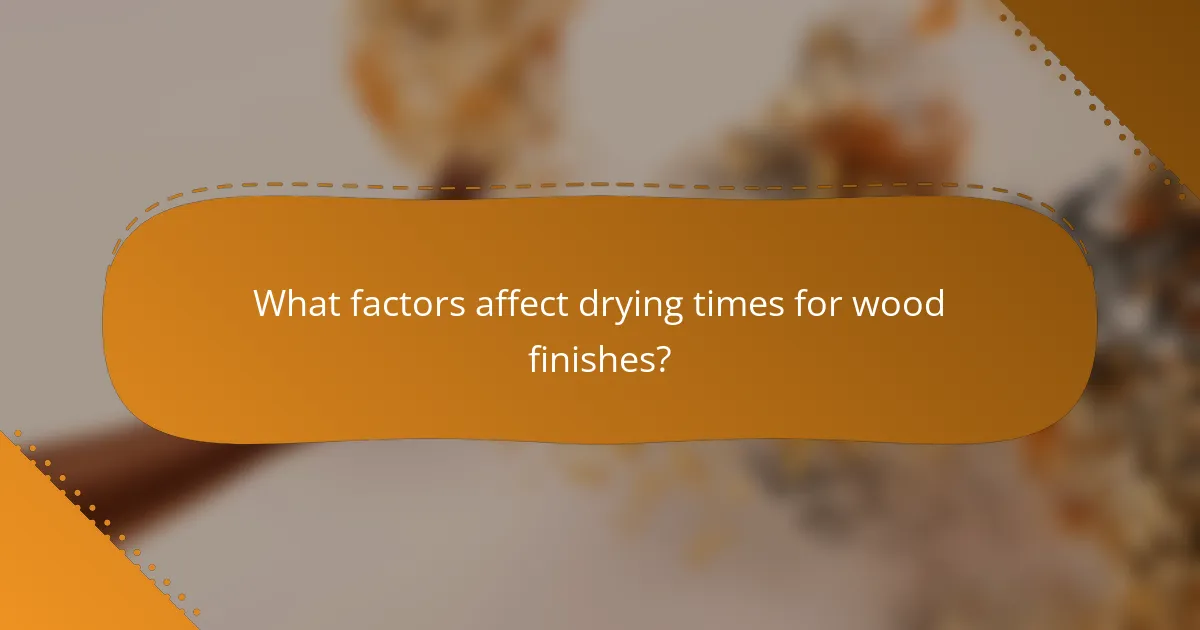Drying times for wood finishes can vary widely depending on several factors, including the type of finish, humidity levels, temperature, and the thickness of the application. Understanding these elements is essential for achieving the best results in your woodworking projects. By considering methods to enhance airflow and adjust application techniques, you can significantly improve drying times and avoid common finishing issues.

What are the drying times for common wood finishes?
Drying times for wood finishes vary significantly based on the type of finish used. Understanding these times is crucial for achieving optimal results in woodworking projects.
Oil-based finishes: 6-8 hours
Oil-based finishes typically require 6 to 8 hours to dry to the touch. However, full curing can take several days, depending on environmental conditions such as humidity and temperature.
When using oil-based finishes, ensure proper ventilation to facilitate drying. Avoid applying heavy coats, as this can extend drying times and lead to uneven finishes.
Water-based finishes: 2-4 hours
Water-based finishes generally dry faster, with a typical drying time of 2 to 4 hours. These finishes are ideal for projects requiring quick turnaround times.
Despite their rapid drying, water-based finishes may raise the grain of the wood, so sanding between coats is recommended for a smooth finish. Always check the manufacturer’s instructions for specific drying times.
Shellac finishes: 30 minutes to 1 hour
Shellac finishes are among the fastest drying options, taking approximately 30 minutes to 1 hour to dry. This quick drying time allows for multiple coats to be applied in a single day.
Keep in mind that while shellac dries quickly, it is sensitive to water and alcohol, which can affect its durability. Use it in low-moisture environments for best results.
Varnish finishes: 8-12 hours
Varnish finishes require longer drying times, typically between 8 to 12 hours. This extended period is necessary for the finish to harden properly and achieve a durable surface.
To ensure a successful application, apply varnish in thin coats and allow adequate drying time between layers. Avoid rushing the process, as this can lead to issues like bubbling or uneven finishes.

What factors affect drying times for wood finishes?
Drying times for wood finishes are influenced by several key factors, including humidity levels, temperature conditions, the type of wood used, and the thickness of the application. Understanding these elements can help you achieve optimal results and avoid common pitfalls in your finishing projects.
Humidity levels
Humidity plays a significant role in the drying process of wood finishes. High humidity can slow down evaporation, leading to extended drying times, while low humidity can accelerate drying but may cause finishes to dry too quickly, resulting in cracks or uneven surfaces.
As a general rule, aim for humidity levels between 40% and 60% for best results. If you are working in a particularly humid environment, consider using dehumidifiers to help control moisture levels.
Temperature conditions
Temperature directly affects the rate at which finishes dry. Warmer temperatures generally speed up drying times, while cooler conditions can prolong them. For most wood finishes, an ideal temperature range is between 15°C and 30°C (59°F to 86°F).
When working in colder environments, be mindful that finishes may not cure properly, leading to issues such as poor adhesion or a tacky surface. If possible, use heaters or work in a controlled environment to maintain optimal temperatures.
Type of wood
The type of wood you are finishing can significantly impact drying times. Hardwoods, such as oak or maple, often absorb finishes differently than softwoods like pine, which can lead to variations in drying times.
For instance, denser woods may require longer drying periods due to their tighter grain structure. Always consider the wood species and its characteristics when planning your finishing schedule.
Application thickness
The thickness of the finish application is another critical factor affecting drying times. Thicker coats take longer to dry compared to thinner applications. A general guideline is to apply finishes in thin layers, typically no more than 0.1 mm (4 mils) thick, to ensure quicker drying.
When applying multiple coats, allow sufficient drying time between each layer to avoid trapping moisture, which can lead to defects in the finish. Always refer to the manufacturer’s recommendations for specific drying times based on application thickness.

How to speed up drying times for wood finishes?
To speed up drying times for wood finishes, consider using fans, increasing the temperature, and applying thinner coats. These methods enhance airflow, elevate the ambient temperature, and reduce the amount of finish applied, all contributing to faster drying.
Use of fans
Using fans can significantly improve drying times for wood finishes by increasing airflow around the surface. This enhanced circulation helps evaporate solvents more quickly, reducing the overall drying period. Position fans to direct air across the finished surface without blowing dust or debris onto it.
For optimal results, use multiple fans if possible, and ensure they are set to a low speed to avoid disturbing the finish. A gentle breeze is sufficient to promote evaporation without causing uneven drying or surface imperfections.
Increase temperature
Increasing the temperature of the environment where the wood finish is applied can accelerate drying times. Warmer air holds more moisture, allowing solvents in the finish to evaporate faster. Aim for a temperature range of 20-30°C (68-86°F) for most finishes to achieve quicker drying.
Be cautious not to exceed the manufacturer’s recommended temperature limits, as excessive heat can lead to issues like bubbling or cracking in the finish. Using a space heater or working in a heated room can effectively raise the temperature when necessary.
Apply thinner coats
Applying thinner coats of wood finish is one of the most effective ways to speed up drying times. Thinner layers dry more quickly because there is less material for solvents to evaporate from. Aim for coats that are no thicker than a few mils to ensure rapid drying.
While applying thinner coats can reduce drying time, it may require additional applications to achieve the desired finish. Be mindful of the finish type, as some products may require specific thicknesses for optimal performance. Always follow the manufacturer’s guidelines for best results.

What are the best practices for applying wood finishes?
To achieve optimal results when applying wood finishes, focus on thorough surface preparation, proper application techniques, and selecting the right finish for your project. These practices ensure a smooth, durable, and aesthetically pleasing finish that enhances the wood’s natural beauty.
Surface preparation
Surface preparation is crucial for a successful wood finish application. Begin by sanding the wood to create a smooth surface, removing any imperfections or old finishes. Use progressively finer grits, finishing with a 220-grit sandpaper for best results.
After sanding, clean the surface to remove dust and debris. A vacuum or a tack cloth works well for this purpose. Properly prepared surfaces allow finishes to adhere better, reducing the likelihood of peeling or chipping later on.
Proper application techniques
Using the right application techniques can significantly affect the final appearance of the wood finish. Apply finishes in thin, even coats to avoid drips and runs. A high-quality brush, foam applicator, or spray gun can help achieve a smooth application.
Work in manageable sections and maintain a wet edge to ensure even coverage. Allow adequate drying time between coats, following the manufacturer’s recommendations, to enhance durability and finish quality.
Choosing the right finish
Selecting the appropriate finish is essential for achieving the desired look and protection level. Common options include oil-based, water-based, and polyurethane finishes, each offering different benefits. Oil-based finishes tend to provide a rich color and durability, while water-based finishes dry quickly and have lower odor levels.
Consider the specific use of the wood and the environment it will be in. For example, outdoor projects may require finishes with UV protection, while indoor furniture might benefit from finishes that enhance the wood grain. Always test a small area first to ensure satisfaction with the finish choice.

What are the common mistakes to avoid when finishing wood?
Avoiding common mistakes when finishing wood is crucial for achieving a smooth and durable surface. Key errors include skipping essential preparation steps and applying finishes under unsuitable environmental conditions.
Skipping sanding between coats
Skipping sanding between coats can lead to poor adhesion and an uneven finish. Each layer of finish needs a smooth surface to bond effectively, so light sanding with fine-grit paper is recommended between applications.
For best results, sand after the first coat has dried but before applying the next. This process helps to remove any imperfections and creates a better surface for subsequent layers. Aim for a sanding interval of around 2-4 hours, depending on the product used.
Applying in high humidity
Applying finishes in high humidity can significantly extend drying times and affect the final appearance. High moisture levels in the air can prevent finishes from curing properly, leading to issues such as cloudiness or a tacky surface.
Ideally, apply wood finishes when humidity levels are below 70%. If conditions are too humid, consider using a dehumidifier or waiting for a drier day to ensure optimal results. Monitoring local weather forecasts can help in planning your finishing tasks effectively.


